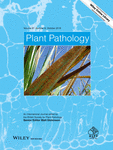Ver ítem
- xmlui.general.dspace_homeCentros e Institutos de InvestigaciónCIAP. Centro de Investigaciones AgropecuariasInstituto de Patología VegetalArtículos científicosxmlui.ArtifactBrowser.ItemViewer.trail
- Inicio
- Centros e Institutos de Investigación
- CIAP. Centro de Investigaciones Agropecuarias
- Instituto de Patología Vegetal
- Artículos científicos
- Ver ítem
Distinct strains of the re-emergent Cassava common mosaic virus (genus: Potexvirus) infecting cassava in Argentina
Resumen
Cassava common mosaic disease (CCMD) has been reported in all regions where cassava is grown in the Americas and
the causal agent, Cassava common mosaic virus (CsCMV), has been identified as a mechanically transmitted potexvirus
(Alphaflexiviridae). In Argentina, cassava is grown mainly in the northeast (NEA) region that shares borders with Brazil
and Paraguay. Increasing incidences of CCMD were observed during the years 2014 to 2016 associated with
[ver mas...]
Cassava common mosaic disease (CCMD) has been reported in all regions where cassava is grown in the Americas and
the causal agent, Cassava common mosaic virus (CsCMV), has been identified as a mechanically transmitted potexvirus
(Alphaflexiviridae). In Argentina, cassava is grown mainly in the northeast (NEA) region that shares borders with Brazil
and Paraguay. Increasing incidences of CCMD were observed during the years 2014 to 2016 associated with severe leaf
mosaic symptoms and yield reductions where the occurrence of CsCMV was confirmed by RT-PCR and sequencing. In
this work, the virus has been successfully purified and a double-antibody sandwich (DAS-) ELISA test has been developed
from an Argentinean isolate of CsCMV to extend the diagnostics of the disease. A collection of 726 samples was screened
and CsCMV was detected with 100% prevalence in the NEA region. Additional co-infecting viruses were detected in
some plants (64.4%); in these, CCMD symptoms correlated with CsCMV only, although more severe symptoms could
be observed in mixed infected plants. Sequence analysis of the conserved RdRp domain showed a wider diversity of
CsCMV isolates. Interestingly, a separate phylogenetic cluster was formed by isolates from the NEA region that only
shared 77.1% to 80.3% nucleotide identity with the other clusters. These results indicate the presence of mixed strains
occurring in the NEA region and suggest the presence of geographically distinct strains of CsCMV in South America.
[Cerrar]

Autor
Zanini, Andrea Alejandra;
Cuellar, Wilmer J.;
Celli, Marcos Giovani;
Luque, Andres Vicente;
Medina, Ricardo Daniel;
Conci, Vilma Cecilia;
Di Feo, Liliana Del Valle;
Fuente
Plant pathology 67 (8) : 1814-1820. (October 2018)
Fecha
2018-10
Editorial
Wiley
ISSN
1365-3059
Formato
pdf
Tipo de documento
artículo
Palabras Claves
Derechos de acceso
Restringido
 Excepto donde se diga explicitamente, este item se publica bajo la siguiente descripción: Creative Commons Attribution-NonCommercial-ShareAlike 2.5 Unported (CC BY-NC-SA 2.5)
Excepto donde se diga explicitamente, este item se publica bajo la siguiente descripción: Creative Commons Attribution-NonCommercial-ShareAlike 2.5 Unported (CC BY-NC-SA 2.5)

